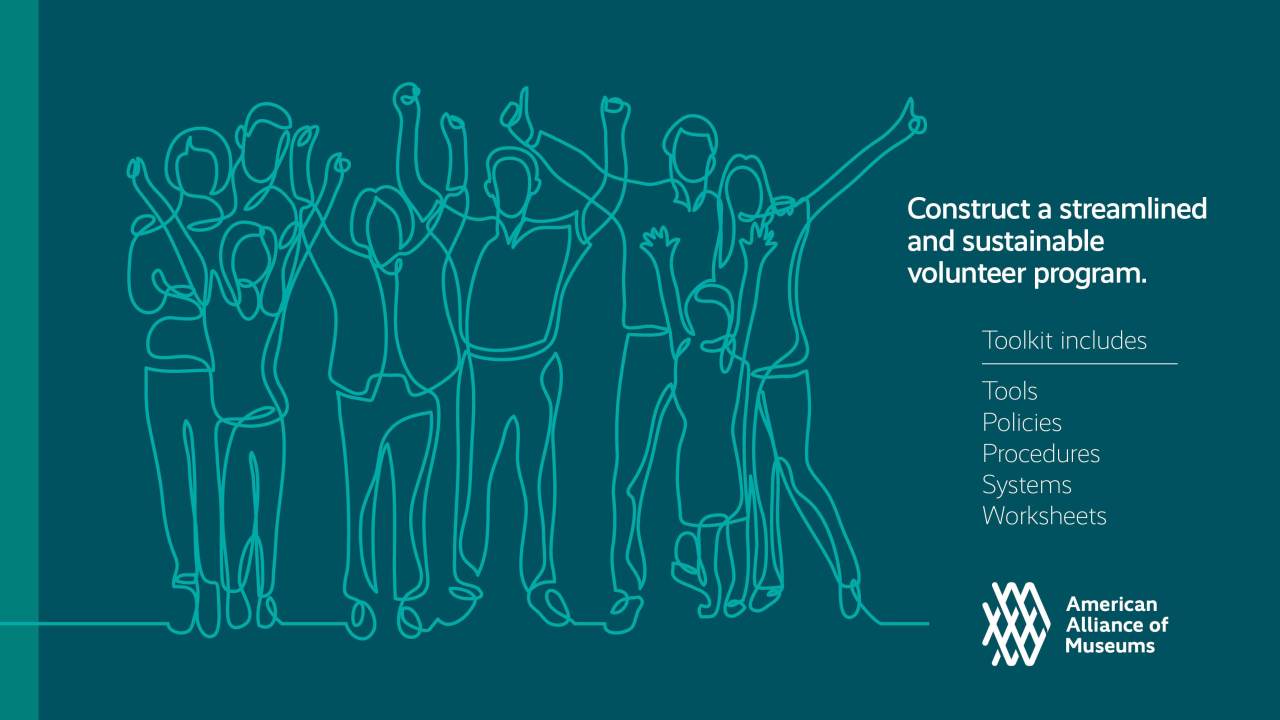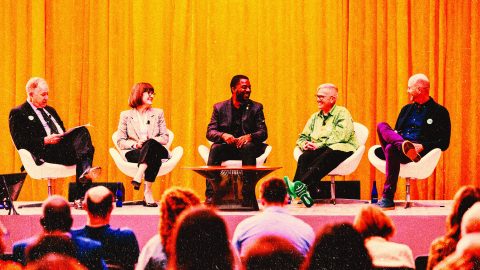
Last year, AAM released a popular toolkit on structuring, developing, and supporting volunteer programs—whether starting from scratch or reimagining an existing program. Since the release of Designing a Museum Volunteer Program, many museums have found themselves in the latter category, as they both cope with the effects of the pandemic and act on the commitments they made during the peak of the Black Lives Matter protests.
In her second appearance on the American Association of Museum Volunteers podcast Volunteer Voices, the toolkit’s author Susan Zwerling spoke with Kia Hunter about diverse, equitable volunteer programs: What barriers do existing programs present to inclusivity and accessibility, and how can we dismantle them? Listen to the episode or read the transcript below to find out.
Kia Hunter:
Welcome to Volunteer Voices, a podcast about volunteerism in the museum field, produced by the American Association for Museum Volunteers.
Today’s episode is the second podcast in a series of three AAMV conversations about best practices and concerns related to designing a museum volunteer program. These podcasts continue a project that began several years ago when Susan Zwerling, Museum Assessment Program Officer with the American Alliance of Museums, designed a survey to gather thoughts from the museum field about museum volunteerism and a potential toolkit to support that work.
The survey was originally created as a Johns Hopkins University museum studies graduate internship project with AAM. The result was a robust dialogue and AAM blog posts and a project that took on a life of its own. Zwerling created the designing a museum volunteer program toolkit to be aligned with core standards of both of these organizations. Since AAM published the toolkit in December of 2019, hundreds of museum professionals have purchased it to help guide their volunteer program planning. You can access the toolkit aam-us.org/toolkits or via AAMV’s website. The toolkit is organized into three sections, exploring key components of a successful museum volunteer program framework.
Our first podcast explored topics related to section one of the toolkit, structuring a volunteer program. You can listen to the podcasts via our website or on the American Alliance of Museum’s website. Today’s podcast focuses on developing a volunteer program, which is the second section of the toolkit. I am Kia Hunter, AAMV board member and volunteer manager at the International Spy Museum in Washington, DC. Joining me today is Susan Zwerling, author of the toolkit. Welcome, Susan.
Susan Zwerling:
Oh, thank you, Kia. It’s so good to be back and to continue the partnership between our two organizations. The toolkit was tons of fun to work on, and it explores key elements and components that are needed in each of those three phases of developing a volunteer program. So there are worksheets, checklists, tips, and resources to help either begin or continue a volunteer program at your museum. And section two, as you said, focuses on moving from what is needed to create a basic program structure and foundation, to exploring what might be needed to further develop your program, such as volunteer orientation and training, evaluation, recognition and rewards, and professional development. The toolkit is focused really specifically on the framework of a successful volunteer program. And so our conversation today is a great opportunity to dive in more deeply and further expand on those topics.
Kia Hunter:
Well, it sounds like we have a lot to discuss today, so let’s jump right in. In part one of this series, you spoke a lot about volunteer programs serving the museum mission, and volunteers representing the communities that we serve. I think this is a very important point that applies not only to structuring your program, but developing it as well. We are developing these programs for institutions, but also for the volunteers and even the guests. Those are a diverse set of stakeholders. How can we develop our orientation and trainings to encourage diversity of participation and accurately reflect those diverse stakeholders?
Susan Zwerling:
Well, yes, museums do have very diverse stakeholders. And of course, that means that the volunteer program does as well. The orientation and training design of the program can actually unwittingly limit diverse participation. So it’s important to question the existing onboarding structure of your program. How can you create flexibility in your policies and your trainings to support broader accessibility? And scheduling is often one of the first barriers we can think about removing.
When I look at a museum’s website, to better understand their volunteer opportunities, well, it frankly makes my heart sink just a little bit, when I see that volunteer orientations or trainings are only scheduled during a 9:00 to 5:00, Monday through Friday time slot. Sticking to that very traditional model means that an institution is likely missing out on engaging volunteers who often bring amazingly rich expertise and knowledge, and are frequently really motivated to contribute to museums.
Another point to think about is that most museums are open weekends and at least some evenings. If we’re seeking volunteers who are available during those hours, it seems like offering training during those timeframes makes sense. So if your goal is to have a diverse, accessible volunteer corps that includes students, full-time and part-time employed individuals, people who work changing shifts, as well as retired folks, you need to consider their needs and expectations.
There’s another diversity, equity, accessibility, and inclusiveness-, or DEAI-, related aspect of volunteer training that involves becoming more aware of implicit bias and reassessing your training content with that in mind. That, in turn, might lead to reassessing your interpretation approach, if your museum uses volunteers as gallery or tour guides, for instance. So some of our listeners might even be familiar with the recent article that came out in Slate, Museums Have a Docent Problem, which explores some pretty thorny issues facing museums today, in terms of volunteer diversity.
Kia Hunter:
I’m glad you brought that article up. I did read it as well, Susan, and you’re right. It speaks directly to this idea of encouraging diversity of participation and how many of our existing structures and volunteer programs can be unconsciously set up to exclude different groups of people. At our museum, for example, we talk about the importance of universal design during our trainings and how it can be applied to guest services through our volunteer program. And in today’s discussion, we haven’t yet mentioned the disabled community, and they’re often left out of this conversation when considering how to develop volunteer programs and making orientations and trainings accessible to them. Their needs might be different, but we should still be creating structures that allow for accessible onboarding and training.
An example I heard from another museum is making sure that all of your training materials are in text form, even if you’re giving a presentation. Or even providing a detailed schedule to volunteers before training begins to allow for more preparation time for individuals who might need it. There must be other ways we can think more creatively about solutions to being more inclusive and accessible with developing our volunteer programs.
Susan Zwerling:
Oh, I agree, Kia. Another example that comes to my mind is that the pandemic has forced so many of us to embrace new technologies and learn how to work remotely. So everything has a silver lining, and our improved abilities to use tools and resources like Google Hangouts, Zoom, SurveyMonkey, et cetera, means that we’re now better positioned to really get creative. Technology tools that expand a person’s ability to see or hear, for instance, can open up new opportunities for some of our volunteers. Some museums are now open to the public, and they’re using technology to offer safer ways to engage with the public. The Air and Space Museum, for example, is one of several museums that are using volunteers to remotely staff a welcome desk or an information desk for visitors by using a flatscreen and a webcam. And this has been so successful with both guests and volunteers that the museum recently added another volunteer staff flat screen and a gallery, and they have plans for more in the near future.
And circling back to that issue of scheduling, staff resistance to offering evening and weekend volunteer trainings might be reduced if some of those hours could be offered from the comforts of their home, by using technology. So we can now create hybrid approaches that might combine a recorded PowerPoint available 24/7, for instance, with scheduled live Zoom meetings or webinars. And then we could follow up with a series of written activities or a questionnaire on SurveyMonkey. So not only can technology help us be more accessible and inclusive, but we can also keep in mind that using it to support spreading out training sessions over time can also increase comprehension and retention of information for our volunteers.
Kia Hunter:
That makes a lot of sense. And I would think that these hybrid approaches as well would keep things interesting. You’re diversifying the presentation formats, keeping people on their toes. My museum, we have already started using some of the strategies that you mentioned. Not the information desk, that does sound very cool though. Filming trainings, though, for example, we’ve started doing that for those who can attend or want to view it later on their own time. We’ve also made many of our virtual public programs available on our YouTube page. And some of our volunteers have been using those resources for professional development and continued learning.
In addition to providing options and training, like what you talked about, offering free parking or even school credit to high school students or college students can be another way to make museum volunteering more appealing to diverse audiences. Some museums, including mine, offer done-in-a-day volunteer opportunities as well. So families can volunteer together. We initially created this offering for families after I reached out to a couple of young parent bloggers who wanted to promote our volunteer opportunities and help us out, but they needed to be able to bring their young children with them. I’m sure there are other resources to tap into that are right under our noses. And there seem to be a lot of benefits to thinking more deliberately about DEAI.
Susan Zwerling:
Oh yeah, those are great examples, Kia. Many institutions begin exploring diversity by asking a basic but complex question. How well do you represent your community in your key stakeholder groups? And the stakeholders, as we talked about before, are diverse. That might include your donors, senior leadership, board members, staff, volunteers, and vendors. So is the museum committed to expanding diversity in all these groups? Looking at the demographics that are represented in your institution, stakeholder groups is a great place to start. Some people find that their volunteer group is demographically more diverse than other stakeholder groups. Other museums might find the opposite, it’s less demographically diverse. Identifying and understanding the dominant culture at a museum is a complicated adventure. Volunteer programs in museums need to embrace diversity on so many levels beyond demographics, though. Communication styles, learning styles, problem-solving styles, attitude towards time, where a person is on the spectrum of introverted to extroverted comfort levels. The better we are at acknowledging and embracing individual differences of all kinds, the more successful we’re going to be at recruiting, onboarding, and retraining people.
And I’d like to share one more point about DEAI, as it relates to volunteer programs. Inclusiveness is different from diversity because inclusiveness relates to who has access to information, who’s included in key conversations, who has input on decisions and policies, and who makes decisions. It’s about who in the museum has power to fully participate and who does not. And that inclusiveness, or lack of inclusiveness, impacts your potential for actual relevancy and perceived relevancy. If your volunteer program isn’t seen as relevant to your museum’s priorities and goals, you will have less value and less power. If your program and/or your institution isn’t seen as relevant to the community and its issues and priorities, you will struggle to attract volunteers.
Kia Hunter:
Well, that makes a lot of sense. And thinking more critically about diversity and inclusion is definitely something that I’m hearing a lot of museums are looking at right now. And it seems imperative that volunteer programs be just as involved.
This is a really interesting conversation, Susan, and we could probably spend the entire day on this topic, but I do want to ask you a few other questions. So let’s shift to exploring the volunteer evaluation process, because evaluation is a great way to get a pulse on how well your program is doing, if it’s sustainable, and where it can be improved. And that might even include improvement in your DEAI offerings as well. So how did you narrow down the evaluation assessment and the toolkit into three parts, individual volunteer performance, overall program meeting volunteer needs, and overall program meeting museum needs?
Susan Zwerling:
Yeah, these three categories of evaluation are a way to approach museum volunteerism through the lens of meeting the needs of multiple stakeholders. So it’s been my experience that we tend to do really well with serving volunteers for satisfaction levels and measuring some performance criteria. We also typically do pretty well with basic quantitative measurements of the program’s contribution to the institution.
Kia Hunter:
So by quantitative, you mean things like number of volunteers, volunteer hours served, and even the monetary value of volunteer time, right?
Susan Zwerling:
Yeah, exactly right. But we’re often less focused on evaluating how the program is aligned with the organizational goals and needs. So transparency and communicating that alignment and that value is really key to being able to offer motivation and retention of volunteers, as well as clearly demonstrating the program’s positive contributions to the museum leadership. So your program is going to be more likely to be valued by each of these critical groups of people if you’ve crafted a program that is aligned with their needs, their values, and their goals. And in a well-designed program, the next logical step is to then evaluate those three categories and see if there are any gaps between your program design, your program content, and your actual impacts.
Kia Hunter:
Transparency is key. It makes sense that volunteers will have more buy-in when they feel more connected and know what’s happening within the program. If we tell them that we are mission-driven, but they never get to concretely see or hear about mission deliverables, it can be hard to stay motivated. And on the other end, saying we have volunteers and that they’re helpful is not enough to convince leadership or the board to keep them around or to provide more resources for the program. So within the three categories of museum volunteer program evaluation, where does the volunteer manager come into play? How are they evaluated?
Susan Zwerling:
Yeah. Well, if your organization has a volunteer manager, then I think a 360-degree type of evaluation process is especially important. That’s feedback from multiple layers of the organizational chart plus self-evaluation. And that is the best way to make certain that communication is working, expectations are transparent, and the program is delivering true value. This is the person who is a liaison between all those stakeholders and should be keeping their finger on the pulse of the volunteers, the staff, leadership, donors, and the community. So comprehensive evaluation and self-evaluation help a volunteer manager successfully identify and address key issues, discover any patterns that might be contributing to a concern, and then pinpoint and celebrate successes as well.
As we talk about evaluation, we also need to remember something from the part one of the toolkit, which is a recommendation to include volunteer management and/or training in your staff job descriptions and your staff performance appraisals. If you’re going to expect staff to play a role in this, you need to include that expectation up front in those position descriptions and performance evaluations, as well as provide training for staff on how to successfully manage volunteers.
Kia Hunter:
So as we talk about the staff structure and position descriptions, do you have a recommendation on who the volunteer manager should report to?
Susan Zwerling:
Well, that is an interesting question to look at, Kia. I think it depends on the culture of the organization and the expectations of the volunteer program. So is the program expected to add value to the strategic plan? Or is the volunteer program expected to only provide a focused, more limited role, maybe for guided tours or special events support? The location on that organizational chart should be realistically aligned with the expectations of the program, of the volunteer manager, and of its role in the institution. So, as you know, volunteers have great potential for being able to offer a fresh perspective that might be different from how staff or leadership are viewing a situation. And so in a perfect world, the volunteer manager or coordinator serves on multiple task forces in groups and has access to the board, to leadership, and access to donors. If we want them to truly provide added value, we really have to set them up for success.
But if the institutional expectation is that more narrowly focused role that I just mentioned, I think it would just create frustration and resentment to have a position on the org chart that implies a larger level of authority and responsibility, and is not really accurately reflecting the daily operations and functions of that position.
A final point to make about evaluation is that most of us are truly committed to making a difference. And if those three categories of program evaluation are explored and changes are incorporated as a result, well then, the staff, the volunteers, and the leadership are all part of co-creating together a program that transparently improves with each feedback process. The commitment and the buy-in for the program should grow, as folks see concrete results of their input.
Kia Hunter:
That’s all great advice, Susan. Now obviously, some of our evaluation metrics this year are going to be redeveloped because of COVID-19. Many museums have been closed for months. Some have suspended their volunteer programs. Volunteer hours, which we are already said are a common evaluation metric, or even something like relevancy that you mentioned in your previous answer, those things have changed dramatically in the past six months. How do we rework those evaluation tools, and what other changes might we consider?
Susan Zwerling:
Well, yes, your volunteer evaluation tools might need to be tweaked because of COVID this year. An astute volunteer manager who uses the recruiting, interviewing, and onboarding processes in the toolkit to learn about each unique volunteer and their style of communicating, problem-solving, and so on, can be better tuned into who’s doing well now, who might be getting frustrated, who needs more of something, who needs less of something. But since we might not be able to actually observe our volunteers working or interacting, as we once did in-house, we might need to explore what kinds of outputs they’re producing and also who in the organization they might be helping and supporting indirectly, as well as those more obvious, direct ways of assisting or contributing.
Kia Hunter:
That makes sense. We need to be willing to understand that our outputs may look different and consider the next iteration of policies and procedure changes. So that way, we can get more nuanced information when we’re evaluating. We also might need to check back in with our other museum stakeholders to learn about their shifting goals and priorities and how the volunteer program can best serve those needs. At our museum, for example, we’ve had an influx of volunteers assisting our communications staff, who never really used volunteers before. So those evaluation metrics are definitely going to be different than what we’ve used in the past. And there’s a whole new group of people who are going to have to evaluate the volunteers that they’ve never done before.
Susan Zwerling:
Right. Well, that’s also a great illustration of a museum using volunteers creatively. I also think that recognizing that your volunteers are facing challenges related to the pandemic, that might change the way they want to engage with the museum, is important right now. Some people might be craving interaction and engagement, for instance, due to a really long lockdown period. Others who might be living in a large household might be feeling desperate for a solitary, quiet project. So avoiding assumptions about people probably needs to be done even more deliberately, while working remotely.
Kia Hunter:
I guess we can also look at it as an opportunity to try and connect even more with these individuals and think more creatively on how we do that. I’ve heard of many volunteer managers cold calling their volunteers to check in these days, something they didn’t do very much when volunteers were coming to the museum regularly, whether that was weekly or even monthly. So maybe our volunteers are also serving guests less than internal stakeholders right now, or maybe they’re more dependent on each other, mostly interacting with the museum via volunteer happy hours, or providing lectures to each other via Zoom.
Susan Zwerling:
Yeah. And these points of human connection are so important. Volunteer programs, just by their very existence as physical locations where people would meet up and work together, normally provided opportunities for those more casual water cooler kinds of conversations and chit chat. And those small connections add up over time. And that’s how you build trust, and you gain knowledge and understanding of the people that you’re working with and volunteering with. And that foundation makes it easier to have the more delicate or even uncomfortable conversations later on, if needed, if you’ve already established trust with each other over time.
Kia Hunter:
Well, volunteer recognition and professional development events, they are also good ways to build trust and create community.
Susan Zwerling:
Oh, yeah. Those organized activities and recognition events do provide opportunities to enjoy each other and build trust, but not everyone enjoys those more formal events with large groups of people. When you’re designing a recognition program, it’s a good idea to integrate rewards that are a good fit with different personality styles, just as you would take that into consideration when you’re designing your onboarding. The toolkit recommends incorporating both informal recognition and formal recognition into your game plan.
There’s another tricky thing to figure out, and that is how to integrate new people into a volunteer program that might be a tight-knit community. And using those events can be a place to start, but it’s difficult to build cohesive teams and also be welcoming to newcomers at the same time. Where is that sweet spot? The social events and recognition opportunities help with this, but I think we have to be more deliberate about integrating new folks into a community of volunteers.
For that matter, how do you keep your volunteers feeling comfortable and helping them with change in general? How do we balance stimulation and growth with comfort and trust? These challenges need to be intentionally discussed and explored, I think.
And then there’s other kinds of perks and rewards, beyond traditional events and programs. There’s so many ways we can support volunteers who want to learn new skills and new information. For instance, can you better leverage your museum’s membership perks with state or regional or national organizations and share more of those webinars, the journal articles, or the toolkits? And now that so many conferences are virtual with lowered registration fees, could more volunteers being included? Could you maybe partner up with other cultural institutions in your community to offer professional development opportunities jointly, or to share access to each other’s learning opportunities for staff or volunteers?
Kia Hunter:
That’s a lot of really good suggestions, Susan. I’m definitely going to take a few of those, and they sound like fun, new ways to engage with our volunteers. So it sounds like we’re all agreeing that volunteer recognition is good. But how do we prove that these activities are working the way that we want them to, that they reduce turnover and create a better environment, as well as boost morale? What are some of the metrics that we can measure to prove that the volunteer recognition is doing what we want it to?
Susan Zwerling:
Well, that is complicated. But the short answer is, it’s probably linked to asking the right questions at the right people. Going back to that 360-degree type of approach to evaluation, if we’re asking for targeted specific program feedback from all the stakeholders, this will help you in determining if you really are creating a better work environment, and which aspects of your volunteer program are supporting that particular goal. So you’ve got to ask questions of the right people, and you’ve got to ask questions that are really specifically linked to what you’re trying to accomplish. And I think retention is a really key metric to look at because it’s probably one of the most accurate measurements of how well the program is meeting volunteer needs and expectations. If retention numbers are problematic, we need to be asking volunteers why they aren’t staying. If retention numbers are healthy, we still need to be asking why are volunteers staying. And we’d need to be able to build on that success.
Kia Hunter:
So it sounds like never just being okay with the status quo. If you’re doing something right, you need to find out why you’re doing it right. If you’re doing something wrong, you should find out how you’re doing it wrong.
Well, it sounds like we have come full circle, talking about those many different type of stakeholders again, re-evaluating them and constantly being in communication with them and keeping them engaged throughout this process. In fact, it seems like our conversation today really illustrates that structuring, and then developing a volunteer program includes a lot of overlapping topics. And these topics are not siloed in different buckets because we should constantly be addressing how they all contribute to a successful volunteer program.
And I would really like to recommend to all of our listeners to check out the first podcast in this series, whether you are just starting to think about your volunteer program, you structured your program a year ago, or maybe twenty years ago.
As we mentioned today, living through a pandemic is going to change the way that you operate, and it will also change your goals and priorities. So it’s important to think about these three parts of building a successful volunteer program right now. And you can find the toolkit at aam-us.org/toolkits. To listen to both podcasts, visit our website at aamv.org. Our final podcast in the series, we’ll discuss supporting the museum volunteer program and will be released in the coming months. We look forward to that conversation.
Susan, I think we’ve run out of time today, but I do want to thank you so much for speaking with me. It has been a pleasure.
Susan Zwerling:
Oh, likewise, Kia. Thanks again so much for inviting me to explore some of these really pertinent museum issues together. And I’m looking forward to the final episode of our three podcast conversations on Volunteer Voices.









The reference to 360-degree evaluation of the volunteer coordinator noted “…feedback from multiple layers of the organizational chart… I would hope this also means including the volunteers!